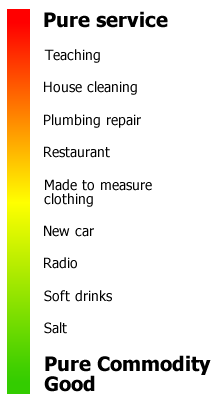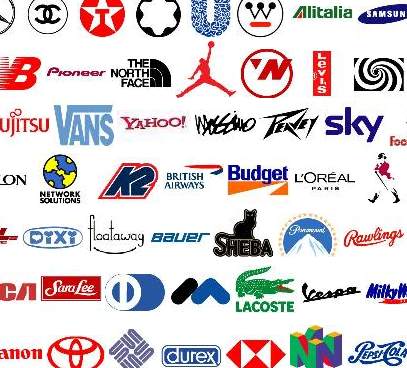
MARK 5320: Advanced Marketing Fundamentals
Chapter 6: Creating Offerings
This modules reviews what comprises an offering, the different types of offerings, how offerings are branded, labeled and packaged and who within the company hierarchy is responsible for these activities.
The three major components of an offering, product, price and service, are discussed in terms of the product-dominant and service-dominant approaches. The difference between product platforms and product lines is also covered. Offerings are products and services designed to deliver value to customers -- either to fulfill their needs, satisfy their "wants," or both.
Most offerings have tangible and intangible components:
Different marketers use the good/product/service terminology different. I believe anything that can be offered for an exchange is a product. Products can be physical items (goods) or intangible items (services). Your book takes a slightly different approach. We will follow what your book states but I wanted to add this as an FYI.

Focus is on the good, rather than the service or price components of the offering. Approach has its roots in the Industrial Revolution firms were product-oriented, meaning they believed that the best way to capture market share was to create and manufacture better products at lower prices. Taking the product-oriented approach means marketing professionals may focus too much on the product itself and not enough on the customer or service-related factors they want. A great example of this is Henry Ford and the Model T. Ford has been quoted as saying "they can have any color they want as long as it is black." Another more recent example would be 3M and its introduction of Post-It Notes, the company originally introduced the product no knowing on who the customer would be. Of course 3M has changed its orientation since the inception of Post-It Notes as the ad below illustrates.
Approach integrates the product, price and service dimensions of an offering. Most customers compare tangible products and the prices charged for them in conjunction with the services that come with them.
A product's technology platform is the core technology upon which it is built. Example - iPod and MP3 technology. The development of a new offering is to take a technology platform and re-bundle its benefits in order to create a different version of an already existing offering. Example - Apple iPod Shuffle and Nano. In some cases, technology platforms developed for one industry or group, may ultimately lead to the creation of new types of offerings. Example - Eqyss's Micro Tek Pet Spray (originally a NASA decontamination product; now used to stop pets from scratching and biting themselves). In a pure services environment, knowledge can be a type of technology platform. Product lines are groups of related offerings with similar marketing strategies. Product lines can be comprised on many offerings or a few offerings. How many offerings there are in a single product line is called line depth. Line breath is how many different or distinct product lines a company has.
Four levels of an offering:

Product-dominant marketing perspective focuses on products, services, and prices as three separate and distinguishable characteristics. It evolved from the concept product-oriented, which means firms believe the best way to capture market share is to create and manufacture better products at lower prices. A technology platform is the core technology behind the product, whereas the product line is comprised on all the offerings developed from the core technology. No, new offerings can be built upon technology platforms originally designed to solve different problems. Or, technologies may be combined to create new offerings. Line depth is the how many offerings there are in a single product line; whereas line breadth is how many different or distinct product lines a company has.
Apple Product Line
The four categories of offerings are discussed and why a single offering might be marketed differently to different types of customers is explained.
Products and services are divided into four general categories for purposes of marketing:
Convenience offerings are products and services consumers generally don't want to put much effort into shopping for because they see little difference between competing brands. Marketing strategy may be limited to simply trying to get the product in as many places as possible where a purchase may occur. Impulse offerings are most closely related to convenience offerings, with Life Savers as the classic example of an impulse buy.
A shopping offering is one for which the consumer will make an effort to compare and select a brand. Consumers believe there are differences between shopping offerings and want to find the right one and/or the best price. They will visit multiple retail locations or spend a considerable amount of time visiting Web sites and reading reviews about the product, such as reviews found in Consumer Reports. Consumers tend to be more brand conscious with shopping offerings.
Specialty offerings are highly differentiated offerings, and the brands under which they are marketed are very different across companies. Marketing specialty offerings requires building brand-name recognition in the minds of consumers and educating them about products' key differences. Examples: exotic perfumes, custom-made motorcycles, fashion goods.
Unsought offerings are those offerings that buyers don't generally shop for until they need them. Examples include funeral home, towing, and locksmith services. It is difficult to market these products. Some organizations try pre-selling, emphasizing cost savings. Others try to create strong name awareness so that when the need for the product arises, their name will come to the mind of the consumer.
This section describes the various types of offerings marketed to businesses and the differences in how they are marketed.
B2B offerings are categorized based on how they are used by the purchaser:
A capital equipment offering is any equipment purchased and used for more than one year and depreciated over its useful life. Marketing is usually done directly with companies since the purchasing decision can be complex and involve many different departments.
Raw materials offerings are materials firms offer other firms so they can make a product or provide a service. Examples include lumber, metals, and manufactured materials such as steel. Raw materials are viewed as commodities so the main competing factor among suppliers is price.
Original equipment manufacturer is a manufacturer or assembler of a final product. An OEM purchases raw materials, manufactured materials and component parts and puts them together to make a final product. These products are not modified, but just built into the final product. One example is tires for cars.
Maintenance, repair, and operating offerings refer to products and services used to keep a company functioning. Example includes janitorial supplies. Companies often will have regular suppliers for goods they buy to maintain their businesses.
Facilitating offerings include products and services that support a company's operations but are not part of the final product it sells. Examples include marketing research services, banking and transportation services, copiers and computers.
This section discusses the branding decisions firms have to make when they are developing new products and the various levels of packaging for new products.
A brand is a name, picture or design, symbol, or combination of these items used by a seller to identify its offerings. Successful branding strategy is one that creates recognition among consumers. A brand name is the spoken part of the brand's identity; a brand mark is the symbol associated with the brand. An important decision companies must make is under which brand a new offering will be marketed. A brand extension involves utilizing an existing brand name or brand mark for a new product category. One thing firms have to consider when they're branding a new offering is the degree of cannibalization that can occur across products. Cannibalization occurs when a firm's new offering eats into the sales of one of its older offerings. Some marketers argue that if a firm doesn't cannibalize its own offerings, its competitors will. The article and clip from Bloomberg Businessweek are interesting.

Global brands
Packaging has to fulfill a number of important functions:

Unique Package Designs
Primary packaging holds a single retail unit of the product and may be used to:
Primary packaging can be bundled together. Secondary packaging holds a single wholesale unit of the product; packaging is not designed to deliver information to customers. Tertiary packaging is packaging designed specifically for shipping and efficiently handling large quantities. Example includes pallets of goods wrapped in plastic.
This section discusses the types of jobs associated with managing offerings within a company.
A brand manager is the person responsible for all business decisions regarding offerings within one brand. By business decisions, we mean making decisions that affect profit and loss, which include such decisions as which offerings to include in the brand, how to position the brand in the market, pricing options, and so forth. Similar to a brand manager in consumer markets, a product manager in B2B markets is, someone with business responsibility for a particular product or product line. Like the brand manager, the product manager must make many business decisions, such as which offerings to include, advertising selection, and others. A category manager has responsibility for business decisions within a broad group of offerings. Brand managers for the group report to the category manager. A market manager is responsible for business decisions within a market. How the market is defined can vary. When marketing managers cover retail, wholesale, etc in a particular industry, they are known as vertical marketing managers.
Job description brand manager
Product manager job description
Category manager